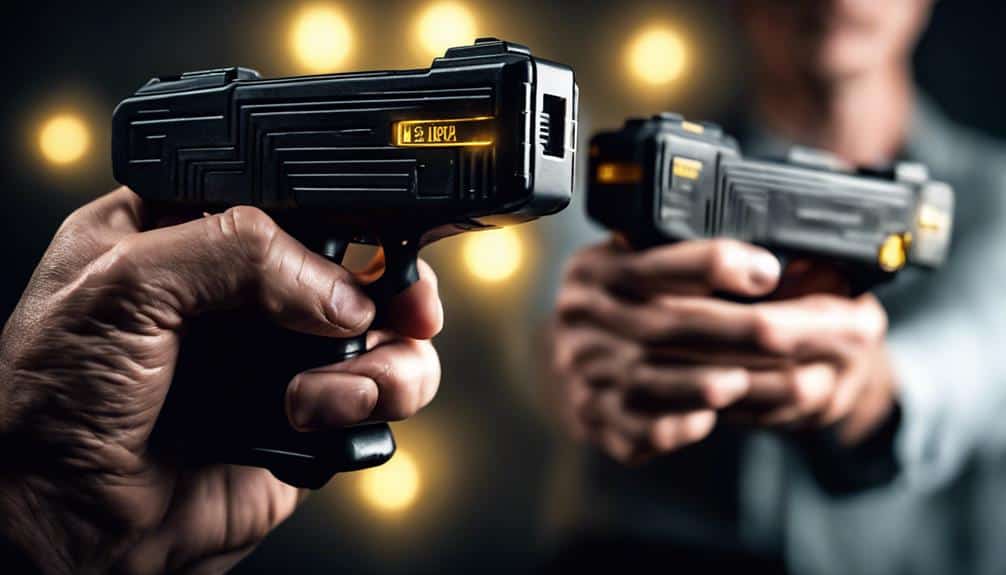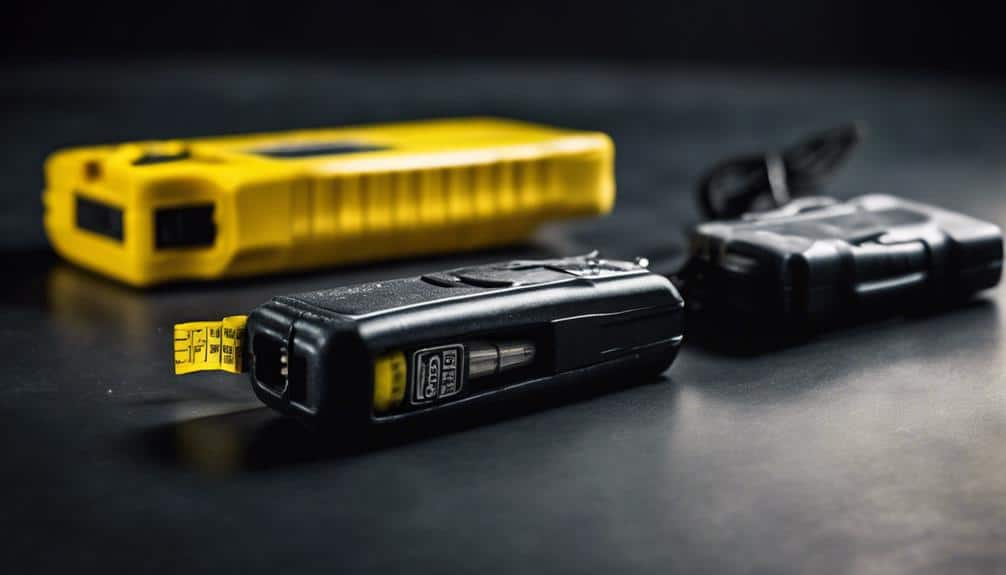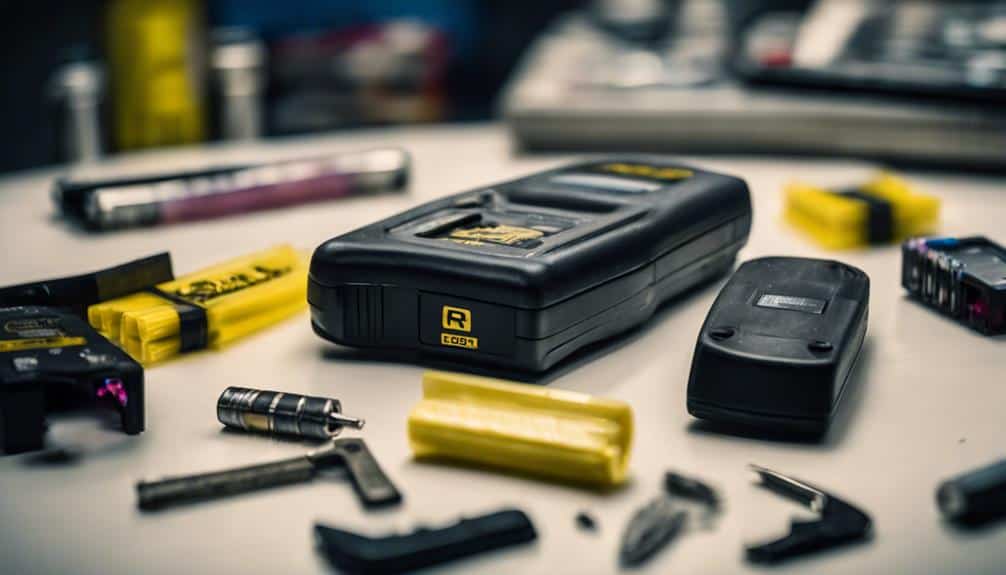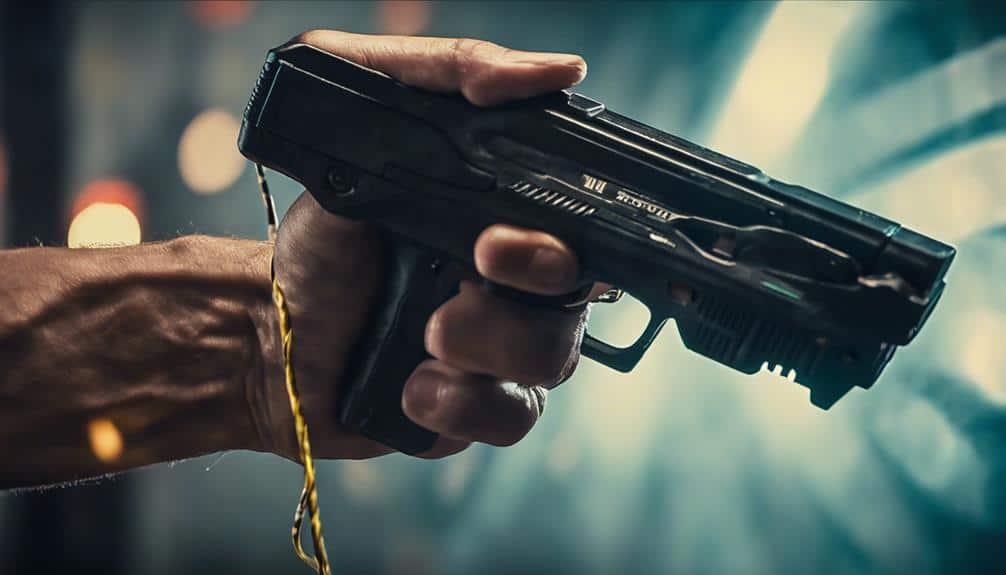When you’re trying to compare the pain between a
stun gun and a
TASER, it’s like choosing between a bee sting and a full-body cramp. A stun gun zaps you with
high-voltage shocks on direct contact, causing sharp, needle-like pain at the spot it touches, but the agony doesn’t linger long. A TASER, though, fires prongs that can hit you from 15 feet away, making your
muscles spasm uncontrollably, and cause pain that radiates throughout your whole body. It feels like your muscles are being twisted and wrung out like a wet towel, lasting longer and hitting harder. Want more details on these shockers? You’re in for a jolt!
Understanding Electroshock Weapons
Understanding
electroshock weapons is essential if you want to grasp the differences between
stun guns and
TASERs. Visualize this: you’re walking home late at night, and you need a reliable
self-defense tool. Stun guns and TASERs come to mind, but which one is right for you? Let’s break it down.
Stun guns deliver
high-voltage, low-amperage shocks through direct contact. Imagine touching a live wire – it’s immediate, localized pain, but it won’t
incapacitate your attacker. They’ll feel it, sure, but they’ll still be on their feet, maybe more annoyed than before. On the upside, stun guns are typically rechargeable and reusable, making them cost-effective in the long run. Additionally,
rechargeable stun guns are environmentally responsible by reducing waste from disposable batteries.
Now, think of a TASER. It’s like a superhero gadget, firing two prongs that can reach up to 15 feet. When those prongs hit, they cause involuntary muscle contractions, often leading to
temporary paralysis. It’s not just pain; it’s incapacitating. Plus, TASERs can
penetrate thicker clothing, so your attacker’s winter coat won’t save them.
Mechanism of Action
When it comes to the mechanism of action, stun guns and TASERs operate quite differently. Stun guns deliver a high-voltage, low-amperage electric shock through direct contact, targeting the skin and muscles. This results in immediate, localized pain and muscle spasms. On the other hand, TASERs use a projectile mechanism, firing two prongs connected by wires. These prongs deliver an electric shock from a distance, causing involuntary muscle contractions across the body and often leading to temporary paralysis. For example,
mini stun guns often come with additional features like LED flashlights, enhancing their utility in low light conditions.
Here’s a quick breakdown:
- Stun guns: Direct contact, immediate pain, localized muscle effect.
- TASERs: Distance delivery, involuntary muscle contractions, potential temporary paralysis.
- Electric pulses: TASERs induce more significant muscle control loss than stun guns.
- Effectiveness: TASERs generally have a broader impact due to their design.
Imagine touching a live wire with a stun gun—painful but not incapacitating. Now, picture being hit by a TASER; it’s like your entire body decides to dance the robot without your permission. The mechanism of action in both devices can be influenced by factors like clothing thickness and battery life, but TASERs usually pack a more substantial punch.
Range of Devices
Although both
stun guns and
TASERs serve the same general purpose, their
operational range sets them apart considerably. If you’re thinking about which one to use, it’s essential to understand how far each can reach. Stun guns require
direct contact with the target, meaning you’ve got to be
up close and personal, within arm’s length. This can be quite risky since you’re in the danger zone. The
SAL Pink Stun Gun offers a
high-voltage shock of 95,000,000 volts, providing potent stopping power at close range.
On the flip side, a TASER device lets you keep your distance, which is a huge advantage. You can hit a target up to 15 feet away with projectile prongs, giving you a buffer zone that can make all the difference in a tense situation. The prongs spread out upon deployment, covering a larger area and increasing the chances of effective incapacitation.
This operational range offers a significant
tactical advantage. Imagine facing an aggressive attacker; would you rather be right next to them or have the ability to zap them from a
safer distance? It’s a no-brainer. TASERs provide that vital space to react and stay safer, while stun guns use their shock power only if you’re close enough to touch.
Pain and Discomfort
Experiencing pain and discomfort from stun guns and TASERs can be vastly different. When a stun gun makes contact with your skin, it delivers high-voltage, low-amperage shocks. This causes intense, localized pain, but it doesn’t incapacitate you. It’s like getting zapped by a thousand tiny needles, all at once. You might yelp, but you can still move. The
LiL Guy Pink Stun Gun specifically delivers 60 million volts, which is designed to be highly effective in self-defense situations.
On the other hand, a TASER shoots dart-like electrodes that latch onto your body and send high-voltage pulses from a distance. This results in involuntary muscle contractions and can temporarily paralyze you. Imagine every muscle in your body suddenly deciding to dance the Macarena — not pleasant!
Pain perception can vary a lot from person to person. Some folks might find a TASER shock excruciating, while others might think it’s just a really bad cramp.
- Stun guns cause localized pain on the skin.
- TASERs result in full-body muscle spasms.
- The pain from a stun gun is usually short-lived.
- TASERs can cause prolonged discomfort due to longer activation times.
As a self-defense tool, a TASER packs a more significant punch, potentially incapacitating an attacker, while a stun gun offers quick, localized pain.
Reusability and Cost
Stun guns offer a significant advantage regarding reusability and cost. When you’re thinking about self-defense, you’ll find stun guns to be much more economical over time. They’re rechargeable, so as long as the battery holds a charge, you can use them again and again. This makes them a more affordable option compared to TASER devices, which require you to replace cartridges after just one or two shots.
Here’s a quick comparison to make it clearer:
| Device |
Initial Cost |
Reusability |
Ongoing Costs |
| Stun Gun |
Under $25 |
Multiple uses |
Recharge battery |
| TASER Pulse+ |
$400 or more |
Single-use cartridges |
$20-$23 per cartridge |
| Stun Gun Battery |
Included |
Rechargeable |
No additional cost |
| TASER Cartridges |
Included |
Single-use |
$20-$23 per cartridge |
| TASER Battery |
$10-$25 |
Single-use |
Replacement costs |
With reliable stun guns like the
Runt Stun Gun costing less than $25, you’re saving a lot compared to the $400 or more you’d spend on a TASER Pulse+. Plus, TASER users face frequent cartridge and battery replacements, adding to the overall expense. So, if you’re looking for a cost-effective way to stay safe, stun guns are definitely the way to go.
Legal Considerations
Before you think about getting a
stun gun or a
TASER, you’ve got to know the rules in your state, and trust me, they’re a mixed bag. Some places might just need a permit, while others might throw the book at you for even having one. In some cases,
personal alarms like keychain alarms or wearable alarms can offer a non-lethal alternative for deterrence. So, don’t skip the homework—check your
local laws and make sure you’re not accidentally turning self-defense into a legal mess.
Local Regulation Awareness
Maneuvering the legal landscape for stun guns and TASERs can be a challenging task due to the patchwork of regulations across different states. You’ve got to be sharp and on top of things because local laws can vary widely. For instance, in some states, owning a stun gun is no biggie, while others might require a permit for a TASER. Then there are places like Wisconsin, where you can use a stun gun, but only under specific conditions. It’s a lot to keep track of. For example,
stun guns are completely illegal in Hawaii, New York, Rhode Island, and Washington D.C., which highlights the necessity for thorough research before making a purchase.
- State Regulations: Some states have outright bans or stringent rules on both devices.
- Self-Defense Laws: You need to know how self-defense laws in your area impact the legality of using these weapons.
- Legal Consequences: Misusing or illegally possessing these self-defense weapons can land you in hot water with fines or criminal charges.
- Constant Changes: Local laws can change frequently, so staying informed is vital for responsible ownership.
Staying aware and informed about these legal regulations is essential for anyone considering owning a stun gun or TASER. Always check the latest local laws to verify you’re not stepping into any legal pitfalls.
Permit and Licensing Requirements
Steering through the legal maze of stun guns and TASERs doesn’t stop at understanding state regulations; you also need to grasp the permit and licensing requirements that come into play. Depending on where you live, the rules can be quite different. Some states let you own stun guns without any licensing at all, while others, like Wisconsin, have specific restrictions. For TASERs, it’s often more complicated; some places require permits, age restrictions, or even training certifications.
For instance, New York and New Jersey have outright bans on both stun guns and TASERs. So, before you think about getting one, you’ll need to know what your local laws say. Misusing these devices isn’t just dangerous; it can also lead to serious legal trouble, like fines or criminal charges. It’s super important to stay up-to-date with local ordinances because laws can change, affecting the legality and permit requirements for these electroshock devices.
Here’s a quick look at how different states handle these regulations:
| State |
Requirements |
| Wisconsin |
Permitted with specific restrictions |
| New York |
Ownership prohibited |
| New Jersey |
Ownership prohibited |
Understanding these legal regulations can save you a lot of headaches (and potentially some hefty fines).
Usage Restrictions Compliance
Maneuvering the legal landscape of stun guns and TASERs means you’ve got to stay on top of usage restrictions and compliance. It’s not just about grabbing one for self-defense; you’ve got to explore the nitty-gritty of legal regulations. Some states let you carry these devices freely, while others might throw the book at you for even thinking about it without a permit. Additionally,
self-defense keychain tools like pepper sprays and panic alarms also have their own set of legal considerations.
In Wisconsin, for example, you can own a stun gun, but there are hoops to jump through. TASERs, on the other hand, come with a whole rulebook, and you’d better be ready to follow it. Misuse or illegal possession. That’s a one-way ticket to fines or criminal charges.
Here’s what you need to keep in mind:
- State Laws: Each state has its own rules. Some states ban stun guns and TASERs outright.
- Permits and Training: You might need a permit or specific training to own or carry one.
- Acceptable Use: Know when and how you can legally use these devices for self-defense.
- Local Ordinances: Don’t forget to check city or county regulations.
Effectiveness in Self-Defense
When it comes to
self-defense, a Taser often outshines a stun gun because it lets you keep a safe distance, up to 15 feet, while still
incapacitating your attacker. The longer activation duration of a Taser, usually between 15 to 30 seconds, gives you essential time to escape, unlike a stun gun’s 3 to 5 seconds of pain. Plus, Tasers disrupt muscle control, causing
temporary paralysis, making them more effective in real-life situations where every second counts.
Pain and Incapacitation Levels
In evaluating the
pain and
incapacitation levels of
stun guns and
TASERs for self-defense, it’s clear they operate differently and yield distinct results. When you use a stun gun, it delivers
high-voltage, low-amperage shocks. This causes immediate pain and
muscle spasms, but it doesn’t usually incapacitate an attacker. On the other hand, a TASER uses projectile prongs to reach targets up to 15 feet away. It delivers high-voltage pulses that induce involuntary muscle contractions, potentially leading to
temporary paralysis.
- Stun guns cause localized pain and muscle spasms.
- TASERs can affect the entire body, causing more significant physical effects.
- Activation duration for stun guns is 3 to 5 seconds.
- TASERs can operate for 15 to 30 seconds, increasing their incapacitating effect.
The pain from a stun gun is sharp and immediate, like touching a hot stove, but it’s all about the instant “ouch.” TASERs, however, bring a more severe reaction. It’s like your entire body gets hijacked by electrical pulses, making you feel like a puppet with cut strings. The range and duration of TASER activation amplify their incapacitating effect, making them generally more effective in
immobilizing attackers. So, while both cause pain, the TASER takes the prize for incapacitation.
Range and Safety Buffer
Using a TASER in self-defense offers a notable advantage over stun guns due to its range and safety buffer. Imagine you’re in a sticky situation, and the last thing you want is to get up close and personal with an attacker. With a TASER, you can incapacitate a target from up to 15 feet away. This distance gives you a vital safety buffer, keeping you out of immediate danger.
Stun guns, on the other hand, require direct contact. That means you’ve got to be close enough to touch the attacker, which can put you at greater risk. The TASER’s projectile mechanism allows for remote engagement, which is a game-changer in self-defense.
Here’s a quick comparison:
| Device |
Range |
Safety Buffer |
| TASER |
Up to 15 ft |
High |
| Stun Gun |
Direct |
Low |
Plus, when those TASER prongs hit, they spread out to cover a larger area, making it easier to incapacitate the attacker effectively. Stun guns only deliver pain where they touch, which isn’t always enough. In self-defense, understanding the range and tactical applications of both devices can greatly improve your effectiveness, making TASERs the clear winner for maintaining distance and safety.
Activation Duration Impact
Activation duration plays a critical role in determining the effectiveness of self-defense devices. When considering a stun gun or a TASER, you’ll notice some key differences in how long they work and how well they protect you.
- Stun gun: Activates for 3 to 5 seconds, causing immediate pain but not incapacitating an attacker. Devices like the BashLite Stun Gun offer 85,000,000 volts, delivering a powerful shock.
- TASER: Activates for 15 to 30 seconds, disrupting muscle function and effectively incapacitating the attacker.
- Effects: The longer activation duration of a TASER allows for greater physiological effects, such as involuntary muscle contractions.
- Self-defense planning: Understanding activation duration helps you choose the right device for an extended window of effectiveness.
A stun gun’s brief activation duration might leave you vulnerable after the initial shock wears off. Imagine holding a stun gun; it zaps, your attacker yelps, but they might still come at you. Not ideal, right?
Now, picture using a TASER. You pull the trigger, and bam! The attacker drops, muscles twitching, giving you precious seconds to escape. That extra activation duration is what makes a TASER more effective for self-defense.
Choosing the right device depends on how long you need to incapacitate an attacker. For sheer effectiveness, a TASER’s longer activation duration offers a clear advantage, ensuring you get away safely.
Factors to Consider
When comparing the pain caused by stun guns and TASERs, several critical factors come into play. First off, a
stun gun delivers high-voltage, low-amperage shocks that mainly cause
localized pain. You might feel a sharp, intense jolt where the device touches you. On the other hand, a
TASER shoots out pronged projectiles that can deliver
electric shocks from a distance, causing
widespread involuntary muscle contractions. Ouch, right? This generally leads to
higher pain levels and greater incapacitation. Many people find that stun guns offer a
non-threatening self-defense option, making them suitable for various situations.
You also need to take into account how long these devices can operate. A TASER can keep shocking for 15 to 30 seconds, while a stun gun usually maxes out at around 3 to 5 seconds. This
extended duration means a TASER might feel way worse. Clothing thickness and the body part targeted also matter. TASERs are designed to
penetrate clothes better, making them more effective in different scenarios.
Both devices aim to help you in self-defense without causing permanent harm, but a TASER might scare off attackers more due to its
intense physical and psychological effects. So, when you think about pain and effectiveness, TASERs generally pack a more powerful punch.
Frequently Asked Questions
Does Getting Tased by a Stun Gun Hurt?
Getting tased by a stun gun can hurt, but it depends on your pain threshold. The electrical shock causes immediate pain and muscle contractions. The duration effects are short, and recovery time is typically quick.
Is a Stun Gun Good for Self-Defense?
A stun gun can be a good self-defense option due to its affordability and reusability. However, consider its effectiveness, legal implications, and personal safety. User experiences vary, so explore alternative weapons to find the best match.
Imagine you’re facing an attacker. A TASER’s effects cause intense pain and temporary paralysis, giving you a better escape chance. Pepper spray, while painful, mainly disorients. Both self-defense tools have safety concerns, but TASERs typically hurt more.
Does a Stun Gun Have to Touch Skin?
A stun gun doesn’t have to touch the skin directly. However, for ideal stun gun mechanics and electrical discharge effects, it’s best to press it against the skin. Always consider safety precautions, pain threshold comparison, and legal implications.









11 Responses